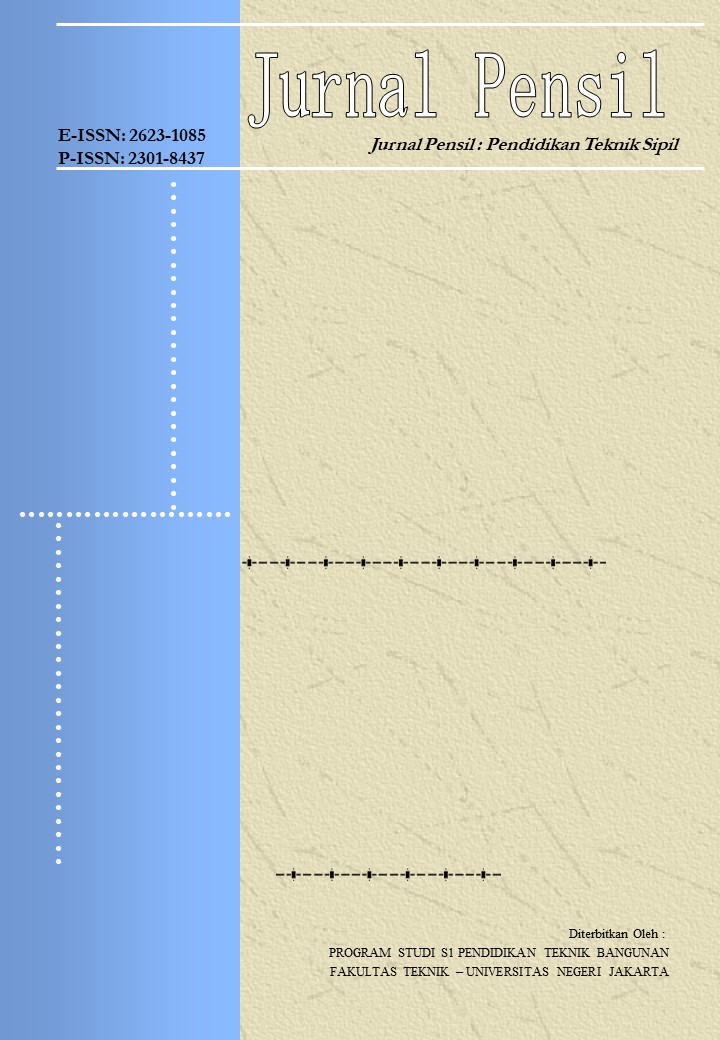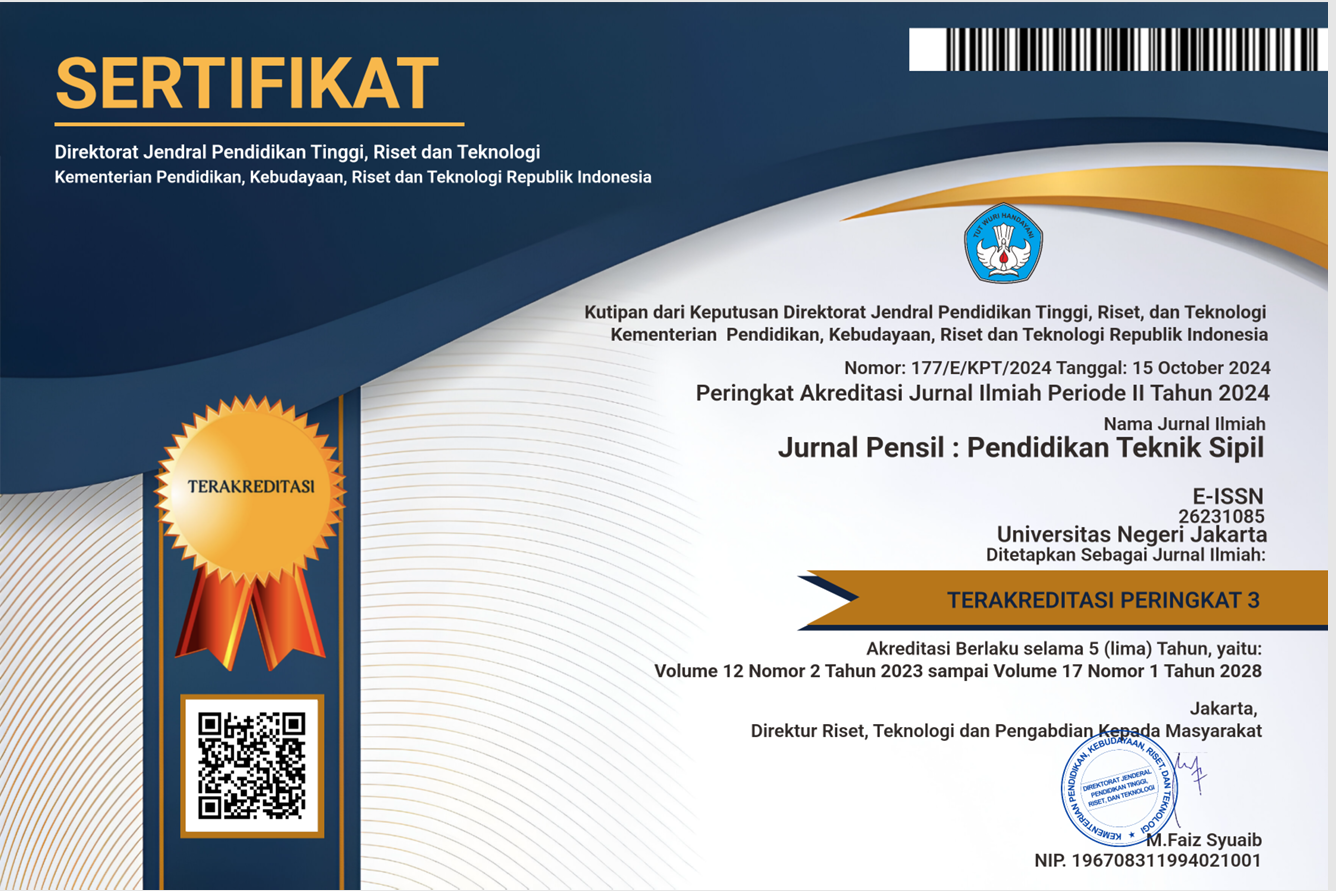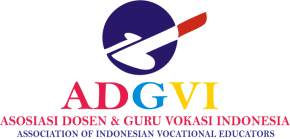RAIN WATER HARVESTING AT THE PLANTATION
DOI:
https://doi.org/10.21009/jpensil.v11i2.25805Keywords:
Rain water harvesting, Rationale method, plantation, Bili-biliAbstract
This study aims to analyze the rainwater harvesting system and calculate the volume of rainwater that can be accommodated for water needs at the plantation site. The research method used is the Rational method. The data used are rainfall data and catchment area which are then calculated using hydrological analysis and hydraulics analysis. The calculation of the average daily rainfall uses the Gumbel method, while the calculation of rainfall intensity uses the Vanbreen method with the Talbot formula, and to find the channel discharge using the Rational method. From the results of the calculations and analysis above, it can be concluded that 1) Rainwater harvesting can be used as an alternative for managing water resources on plantations. 2) The intensity of rainfall for the 5-year return period is 30,644 mm/hour. 3) the catchment area of the garden house 2 x 13.5 m2 can produce a rainwater discharge of = 0.0000828050 m3/second. 4) The volume of 2 sewer tanks can accommodate 1570 liters of water. 5) Farmers can take advantage of stored rainwater for up to 20 days.
References
Al-Salaymeh, A., Al-Khatib, I. A., & Arafat, H. A. (2011). Towards sustainable water quality: management of rainwater harvesting cisterns in Southern Palestine. Water Resources Management, 25(6), 1721–1736.
Aladenola, O. O., & Adeboye, O. B. (2010). Assessing the potential for rainwater harvesting. Water Resources Management, 24(10), 2129–2137.
Ali, I., Suhardjono, S., & Hendrawan, A. P. (2017). Pemanfaatan Sistem Pemanenan Air Hujan (Rainwater Harvesting System) Di Perumahan Bone Biru Indah Permai Kota Watampone Dalam Rangka Penerapan Sistem Drainase Berkelanjutan. Jurnal Teknik Pengairan: Journal of Water Resources Engineering, 8(1), 26–38.
Almazroui, M., Islam, M. N., Balkhair, K. S., Şen, Z., & Masood, A. (2017). Rainwater harvesting possibility under climate change: A basin-scale case study over western province of Saudi Arabia. Atmospheric Research, 189, 11–23.
Andreas, A., Meutia, W., Ariyani, D., & Sundari, A. S. (2021). APLIKASI DAN PENYULUHAN PEMANFAATAN LUBANG RESAPAN BIOPORI UNTUK MENGATASI KEKURANGAN AIR DI DESA LEUWISADENG KABUPATEN BOGOR. Jurnal JANATA, 1(1), 24–29.
Asrib, A. R., & Arfandi, A. (2018). Perumahan Tamarunang dalam memelihara drainase lingkungan.
Auliyani, D., & Wahyuningrum, N. (2020). POLA HUJAN DI BAGIAN HULU DAERAH ALIRAN SUNGAI BENGAWAN SOLO DALAM PERENCANAAN PEMANFAATAN SUMBER DAYA AIR (Rainfall pattern for water resources utilization planning in the upperstream of Bengawan Solo Watershed). Jurnal Penelitian Pengelolaan Daerah Aliran Sungai (Journal of Watershed Management Research), 4(1), 53–62.
De Kwaadsteniet, M., Dobrowsky, P. H., Van Deventer, A., Khan, W., & Cloete, T. E. (2013). Domestic rainwater harvesting: microbial and chemical water quality and point-of-use treatment systems. Water, Air, & Soil Pollution, 224(7), 1–19.
Falkenmark, M., & Widstrand, C. (1992). Population and water resources: a delicate balance. Population Bulletin, 47(3), 1–36.
Farooq, M., Wahid, A., Kobayashi, N., Fujita, D., & Basra, S. M. A. (2009). Plant drought stress: effects, mechanisms and management. In Sustainable agriculture (pp. 153–188). Springer.
Florince, F., Arifaini, N., & Adha, I. (2016). Studi Kolam Retensi sebagai Upaya Pengendalian Banjir Sungai Way Simpur Kelurahan Palapa Kecamatan Tanjung Karang Pusat. Jurnal Rekayasa Sipil Dan Desain, 3(3), 507–520.
Hadipuro, W. (2010). Indonesia’s water supply regulatory framework: between commercialisation and public service? Water Alternatives, 3(3).
Hasanuddin, A., Said, M., & Ruslan, M. (2020). Pengaruh Saluran Distribusi, Biaya Pemasaran Dan Volume Penjualan Terhadap Pendapatan Petani Kentang Di Kabupaten Gowa Sulawesi Selatan.
Hasnawir, H. (2012). Intensitas Curah Hujan Memicu Tanah Longsor Dangkal Di Sulawesi Selatan. Jurnal Penelitian Kehutanan Wallacea, 1(1), 62–73.
Kusumastuti, C., & Chandra, H. P. (2021). Rainwater for Domestic Use in Urban Area: A Simulation of Rainwater Harvesting System for Surabaya, Indonesia. In Water Security in Asia (pp. 401–411). Springer.
Lee, K. E., Mokhtar, M., Hanafiah, M. M., Halim, A. A., & Badusah, J. (2016). Rainwater harvesting as an alternative water resource in Malaysia: potential, policies and development. Journal of Cleaner Production, 126, 218–222.
Ma, H., Shi, C., & Chou, N.-T. (2016). China’s water utilization efficiency: An analysis with environmental considerations. Sustainability, 8(6), 516.
Mahmoud, W. H., Elagib, N. A., Gaese, H., & Heinrich, J. (2014). Rainfall conditions and rainwater harvesting potential in the urban area of Khartoum. Resources, Conservation and Recycling, 91, 89–99.
Maryono, A. (2020). Memanen Air Hujan. UGM PRESS.
Muliawati, D. N. (2015). Perencanaan Penerapan Sistem Drainase Berwawasan Lingkungan (Eko-Drainase) Menggunakan Sumur Resapan Di Kawasan Rungkut. Institut Technology Sepuluh Nopember.
Murdiana, A. W., Soesilo, T. E. B., & Bismo, S. (2019). Feasibility study of rainwater conservation and harvesting for industrial community in North Jakarta. IOP Conference Series: Earth and Environmental Science, 311(1), 12056.
Ndiritu, J. G., McCarthy, S., & Tshirangwana, N. (2014). Probabilistic assessment of the rainwater harvesting potential of schools in South Africa. Proceedings of the International Association of Hydrological Sciences, 364, 435–440.
Pacheco-Martínez, J., Hernandez-Marín, M., Burbey, T. J., González-Cervantes, N., Ortíz-Lozano, J. Á., Zermeño-De-Leon, M. E., & Solís-Pinto, A. (2013). Land subsidence and ground failure associated to groundwater exploitation in the Aguascalientes Valley, México. Engineering Geology, 164, 172–186.
Palacio, S., Azorín, J., Montserrat-Martí, G., & Ferrio, J. P. (2014). The crystallization water of gypsum rocks is a relevant water source for plants. Nature Communications, 5(1), 1–7.
Panagos, P., Imeson, A., Meusburger, K., Borrelli, P., Poesen, J., & Alewell, C. (2016). Soil conservation in Europe: wish or reality? Land Degradation & Development, 27(6), 1547–1551.
Rahman, M. M., Rahman, M. A., Haque, M. M., & Rahman, A. (2019). Sustainable water use in construction. In Sustainable construction technologies (pp. 211–235). Elsevier.
Şahin, N. İ., & Manioğlu, G. (2019). Water conservation through rainwater harvesting using different building forms in different climatic regions. Sustainable Cities and Society, 44, 367–377.
Salman, S., & McInerney-Lankford, S. (2004). The human right to water: Legal and policy dimensions. Washington, DC: World Bank.
Sarbidi, S. (2015). METODA PENERAPAN ZERO RUN OFF PADA BANGUNAN GEDUNG DAN PERSILNYA UNTUK PENINGKATAN PANEN AIR HUJAN DAN PENURUNAN PUNCAK BANJIR. Jurnal Permukiman, 10(2), 106–117.
Sari, P. A., Ardiatma, D., & Ismanto, H. (2021). Evaluation of Rainwater Harvesting System On Skin-Deo Factory Cikarang. INCEESS 2020: Proceedings of the 1st International Conference on Economics Engineering and Social Science, InCEESS 2020, 17-18 July, Bekasi, Indonesia, 232.
Shiva, V., & Opel, A. (2013). From water crisis to water culture. In Cultural Studies and Environment, Revisited (pp. 138–149). Routledge.
Sudarmanto, B. (2010). Sistem Drainase Perkotaan yang Berwawasan Lingkungan. Prosiding SNST Fakultas Teknik, 1(1).
Suheri, A., Kusmana, C., Purwanto, M. Y. J., & Setiawan, Y. (2019). Model prediksi kebutuhan air bersih berdasarkan jumlah penduduk di kawasan perkotaan Sentul City. Jurnal Teknik Sipil Dan Lingkungan, 4(3), 207–218.
Tian, Y., Su, D., Li, F., & Li, X. (2003). Effect of rainwater harvesting with ridge and furrow on yield of potato in semiarid areas. Field Crops Research, 84(3), 385–391.
Umum, K. P. (2014). Pengelolaan Air Hujan pada Bangunan Gedung dan Persilnya. Peraturan Menteri Pekerjaan Umum Nomor, 12.
Xu, J., Guo, Z., Li, Z., Li, F., Xue, X., Wu, X., Zhang, X., Li, H., Zhang, X., & Han, Q. (2021). Stable oxygen isotope analysis of the water uptake mechanism via the roots in spring maize under the ridge–furrow rainwater harvesting system in a semi-arid region. Agricultural Water Management, 252, 106879.
Xu, Z. X., Chen, Y. N., & Li, J. Y. (2004). Impact of climate change on water resources in the Tarim River basin. Water Resources Management, 18(5), 439–458.
Yuan, T., Fengmin, L., & Puhai, L. (2003). Economic analysis of rainwater harvesting and irrigation methods, with an example from China. Agricultural Water Management, 60(3), 217–226.
Zhongming, Z., & Wei, L. (2020). In Mali, water is a source of life.











.png)
.png)
1.png)

